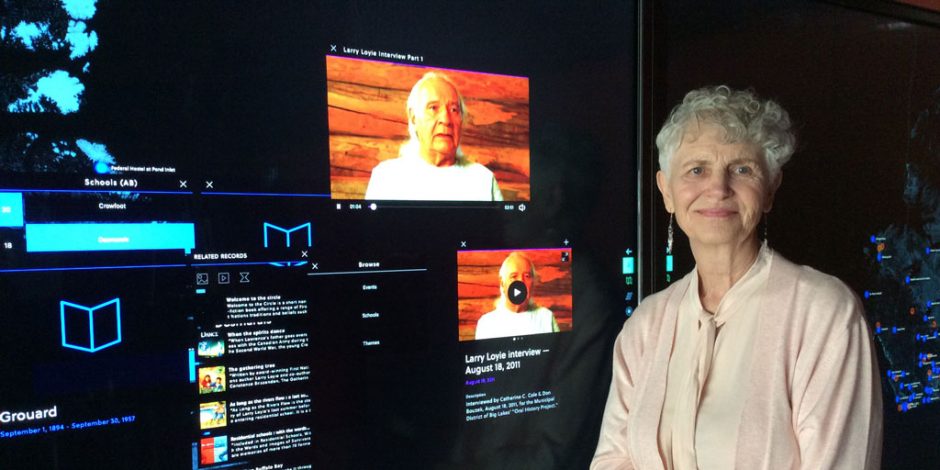The Larry Loyie and Constance Brissenden Collection is the first collection of materials donated to the Residential School History and Dialogue Centre (RSHDC).
The collection highlights the work of Cree author Larry Loyie, a residential school Survivor, and his partner, editor Constance Brissenden. For more than 24 years, the couple researched Indigenous history, and wrote nine books together, including Residential Schools: With the Words and Images of Survivors (Indigenous Education Press). They travelled extensively, giving more than 1,600 talks together at schools and libraries across Canada. Larry Loyie passed away on April 18, 2016. Constance continues to fulfill Larry’s legacy through their archival collection. For more on Larry Loyie, visit www.firstnationswriter.com.
We sat down with Constance to hear more about Larry, his legacy, and her on-going work.

Constance, tell us about the work you do.
I have a Masters in Theatre from the University of Alberta, and after 10 years in Canadian theatre, working as a dramaturge with Canadian playwrights, I shifted to journalism. Over the years, I’ve worked as a writer, editor and book packager, as well as a drama instructor
How did you first meet Larry?
Sometimes the stars align. In the early 1990s, living in Vancouver, I taught a creative writing class at the Carnegie Community Centre on Hastings and Main in Vancouver’s Downtown Eastside. Larry attended the free class. He had a childhood dream of becoming a writer, and was determined to make it come true. I soon learned that Larry was a much better creative writer than I was, and a strong literacy advocate.
Larry wanted to write a play about his six years in residential school. As a former dramaturge (play editor), I started working with Larry on his first play, Ora Pro Nobis, Pray for Us. This play, about the friendship of the boys and how it helped them survive their residential school years, was staged in BC, Alberta, and Ontario. At this point, Larry saw that he could only reach a limited audience with plays. He turned to writing books, and ultimately produced nine books. I worked with Larry as co-author and editor.
What made you want to donate the Larry Loyie and Constance Brissenden Collection to the Centre?
Larry became a great friend of Indigenous programs at UBC through his friendship with Kim Lawson, a librarian at UBC’s Xwi7xwa Library. Larry and several of Kim’s family members fished professionally on the north coast of BC before he started writing in his mid-fifties. Over time, Larry and I participated in activities at the First Nations House of Learning, giving talks and readings, and attending student activities. Larry heartily believed in the Aboriginal Teacher Education Program here.
How does it feel to know these materials will be held at the Centre?
Larry was a residential school Survivor, one of a group of outspoken grassroots voices who wanted the world to know the hidden history of residential schools. He also wanted to share the beauty of his beloved traditional Cree childhood before being forced into residential school at St. Bernard Mission in Grouard, Alberta.
Before his death in 2016 at the age of 82, Larry decided to donate his research collection to the UBC RSHDC. He knew that his life story, professional history, and his extensive research on residential schools (including survivor interviews, academic research, files, photos, and photo research) would be treated with respect and made available to inspire future generations.
What do you want people to know about the collection?
Larry’s life after his mid-fifties, when he was disabled, was dedicated to encouraging people to learn the truth about Indigenous cultures and history. As Larry’s partner for 24 years, I encourage students to view his life in context of a historical turning point. Larry was born in 1933 into a Cree family that practiced a traditional hunting and gathering lifestyle with close family ties. By the end of his life, Larry had made his dream of becoming an award-winning writer a reality through intense commitment. He was deeply aligned with other residential school Survivors and continued his research into residential school history for more than 30 years. All of these elements are entry points for future study.
Will there be further acquisitions?
The majority of Larry’s legacy of books, writing, research, files, photos and interviews are now with the RSHDC. I’m continuing to work on a timeline of Larry’s life, adding details, memories and photographs. There may be additional materials from outside sources. The collection reflects the power of Larry’s voice, a Survivor’s voice, speaking for Indigenous history, education and understanding.
You recently provided images and captions for the ‘Pride and Camaraderie’ sport exhibit featuring Larry. What do you think of the exhibit?
Larry would be thrilled with the Camaraderie exhibit. In his book The Gathering Tree, he made the central character a long-distance runner, knowing that sports were central to Indigenous interests. Larry always encouraged museums and displays to go beyond “the tipi, the buffalo, and the canoe.” Choosing sports is a break-out idea.
—
The Larry Loyie and Constance Brissenden Collection is being processed, but a selection of his books, and video testimony is available on our collections website.